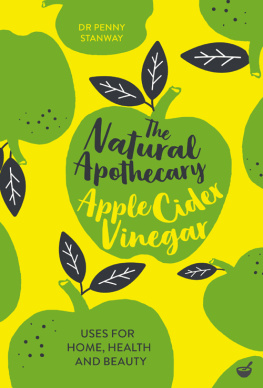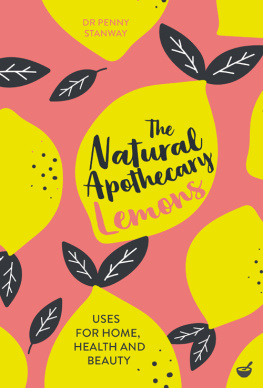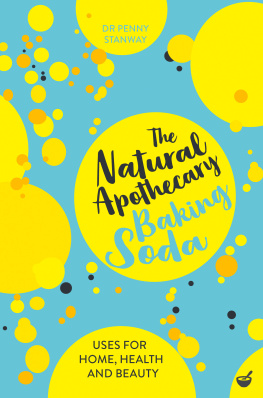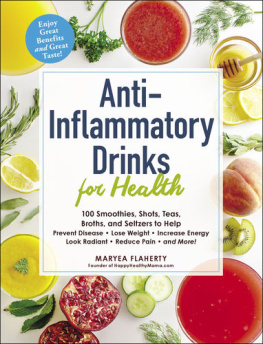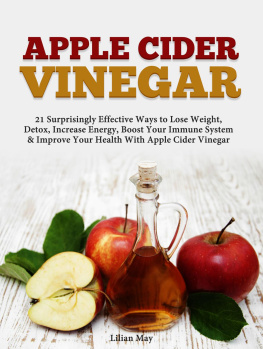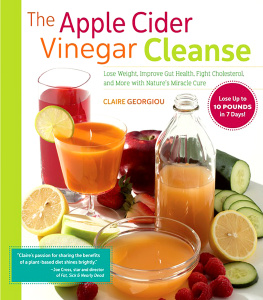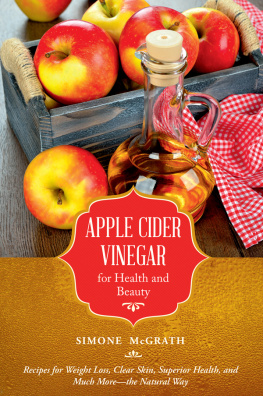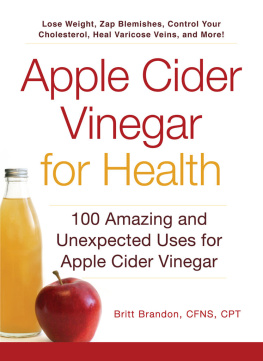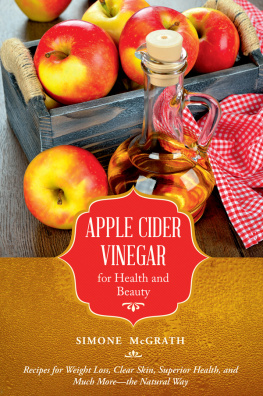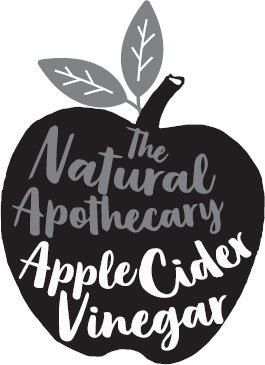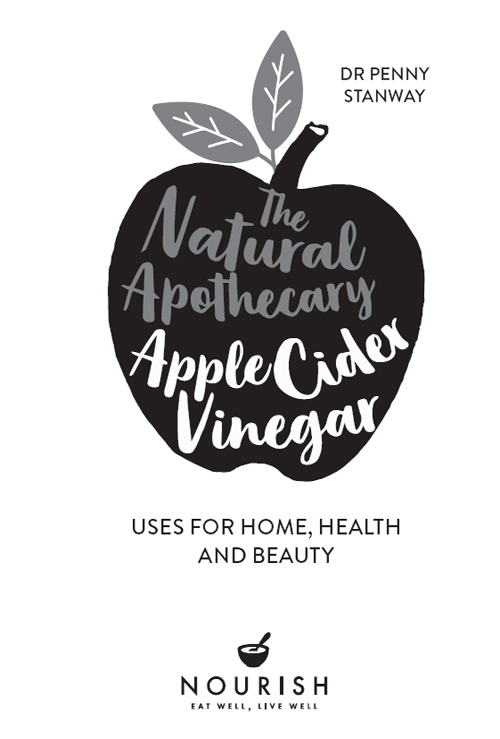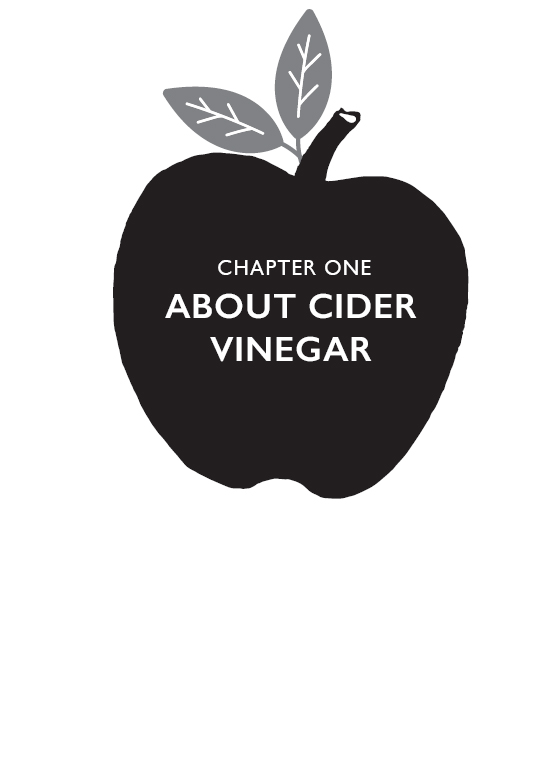Other titles in the Natural Apothecary series include:
The Natural Apothecary: Baking Soda
The Natural Apothecary: Lemons
About the author: Dr Penny Stanway practised for several years as a GP and child-health doctor before becoming increasingly fascinated by researching and writing about healthy diets and other natural approaches to health and wellbeing. Penny has written more than 20 books on health, food and the connections between the two. She lives with her husband on a houseboat in the Thames.
CONTENTS
INTRODUCTION
For many thousands of years, people have been using natural products to soothe, treat, beautify and cleanse. Herbs and spices, vegetables, fruits, nuts and berries (as well as secondary products such as olive oil and vinegar) have been mixed together to create traditional remedies that have been passed down through the generations. Many of these ingredients are still used in commercial products today, although are now often combined with harsh chemicals.
Today, we are used to relying on pharmacies and supermarkets, where there are hundreds of available products, each with a different purpose. We apply creams and ointments for various aches and pains, take vitamin supplements, and spend a fortune on lotions and potions for our skin, nails and hair. The number of cleaning products that are now on offer can be quite overwhelming!
By going back to basics, and taking a more natural approach to how we treat our diets, health, beauty regimes and household management, we are taking back control of what we are putting into our bodies and what we are exposing our families to. Apples, apple juice, cider and cider vinegar have a long history and are much loved around the world, able to promote and protect our health and wellbeing. Whats more, cider vinegar is a cheap and efficient source of help in the home.
Apples are the most popular fruit in the world, and as the saying goes, an apple a day keeps the doctor away.
Archaeologists believe that apple trees originated around the Caspian Sea and the Black Sea, and that people ate apples as far back as 6500 bc. Apple cultivation spread to Europe and in the 16th century King Henry VIII instructed his fruiterer to search the world for the best varieties, so he could set up orchards in England. Apple cultivation spread to the US, Australia, New Zealand, South Africa and South America. Nowadays, more than 7,500 varieties of apple are grown worldwide, and in many countries either home-grown or imported apples are available year-round.
Historians are unsure when people first enjoyed cider, but they know it was a common drink in Britain in the first century bc and think it was probably available around the Mediterranean in the 1st century ad. In contrast, archaeologists say that cider vinegar has been used for much longer, since traces of it exist in Egyptian urns dating from 3000 BC.
The word vinegar comes from the Old French vyn egre, which in turn came from the Latin vinum + acer (wine + sour).
A mild acid, that is relatively easy to produce, vinegar has a long history of use in industrial and medical spheres as well as in the home. Vinegar is a liquid primarily made up of acetic acid and water. It acts as corrosive agent and a preservative as well as being useful as a cleaning fluid. It is inexpensive and readily available, and homemade versions can be made relatively simply.
Vinegar is most often made from fruit or grains, or from alcoholic drinks, such as cider. Other types of vinegar include:
fruit vinegars
balsamic vinegar
cane vinegar
grain vinegar, such as rice vinegar or malt vinegar
spirit vinegars, such as wine vinegars or sherry vinegar
Vinegar has traditionally been thought to offer many health benets, and a surprising number of common ailments can be treated using cider vinegar, see pages .
Vinegar has antibacterial properties and can be used to cleanse and deodorize your body. Cider vinegar is a mild enough acid that is a helpful aid in maintaining the skins natural acidity (see page ).
Cider vinegar is also useful for many household chores and can help keep your home fresh, clean and sparkling. It also makes a great pest-controller! For environmentally-friendly, non-toxic ideas for using cider vinegar as a natural cleaning product, see pages .
NOTE
What the English call apple juice is known as cider or sweet cider in some countries, including the US.
What the English call cider is called hard cider in some countries, including the US.
ABOUT CIDER VINEGAR
Making cider vinegar involves two basic types of fermentation. First, the sugars of apple juice are fermented to the alcohol of cider. Then the alcohol of cider is fermented to the acetic acid of cider vinegar (a process sometimes called acetication). The colour of cider vinegar is a light brownish-yellow. It can be cloudy or clear. It can also be pasteurized (in which case it contains no microorganisms) or unpasteurized (in which case it contains some of the cloudy mass of fermentation bacteria called the vinegar mother).
Before we look at cider vinegar, lets go back to basics, and the fruit which it comes from. When you eat an apple, you arent just getting a sugary source of 50 calories with some fibre and vitamin C. You are consuming a veritable treasure chest of health-promoting substances, some of which occur in such richness in only a few other foods. For example, apples are one of the most plentiful sources of pectin fibre and phenolic compounds such as quercetin. This explains why apples are the fruits most consistently associated with a reduced risk of certain chronic diseases, including heart disease, cancer, and diabetes, and why consuming apples, apple juice and cider vinegar really can make a difference to our health and wellbeing.
Apple juice
Apple juice is called apple cider in the US and parts of Canada. Apple juice diluted with water, or sweetened with added sugar, must be labelled as an apple drink or apple-juice beverage. Juicing apples requires mechanical pressing, which produces cloudy juice.
Other possible processes include:
Filtering of particulate material, including cellulose, pectins and proteins. This produces clear juice.
Pasteurization, to prevent enzymes turning sugars to alcohols, and to protect against the growth of moulds and bacteria. This gives the juice a shelf life of up to two years. Unpasteurized juice should ideally be consumed as soon as possible.
The less processing there is, the smaller the loss of nutrients and other valuable phytochemicals. Cloudy (unltered) juice is slightly richer in fibre than is clear (ltered) juice. It is also much richer in valuable phenolic compounds, containing, for example, a much higher amount of proanthocyanidins. And while it contains around half the amount of phenolic compounds of apples themselves, clear juice contains only up to a third or so.
Cider
Cider is an alcoholic beverage made by the fermentation of apple juice. In the US, any fermented apple juice containing more than 0.5 per cent ABV (alcohol by volume, meaning millilitres of alcohol per 100 millilitres of liquid) is called hard cider. In the UK, 1.2 per cent ABV cider is designated low-alcohol cider. More often, the alcohol content of cider varies from less than 3 per cent ABV (for example, French

